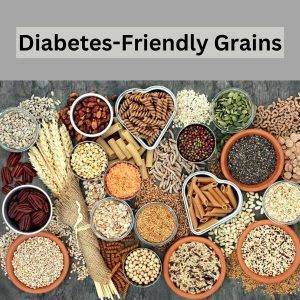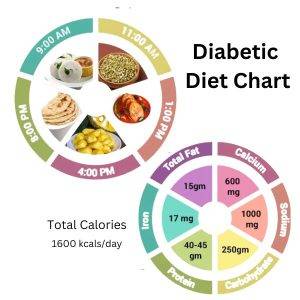“Good Food for a Diabetic Patient: Eating Right for a Healthier Life!”
Overview
Eating a balanced diet that includes a variety of fruits, vegetables, whole grains, lean proteins, and healthy fats can help you manage your diabetes and reduce your risk of complications.
This article will discuss some of the best foods for a diabetic patient.
What is Diabetes and How does it cause?
Diabetes is a very common disease now-a-days. It affects millions of people around the world. It occurs when the body does not produce enough insulin, or when the body cannot use the insulin it produces effectively.
Insulin is a hormone that helps the body to use glucose, or sugar, from the food we eat for energy.
Diabetes causes blood sugar(glucose) to build up in the bloodstream, leading to high blood sugar levels. High blood sugar levels can cause a variety of health problems, including heart disease, stroke, kidney disease, and nerve damage.
Diet for Diabetics: Best Food to Choose
 Here are some of the best foods to choose from when you’re living with diabetes:
Here are some of the best foods to choose from when you’re living with diabetes:
Fruits and Vegetables: Fruits and vegetables are packed with vitamins, minerals, and fiber. They’re also low in calories and fat, making them a great choice for people with diabetes. Try to eat a variety of different colors of fruits and vegetables to get the most nutrients.
Whole Grains: Whole grains are a great source of fiber, which can help you feel full longer and keep your blood sugar levels stable. Look for whole-grain bread, cereals, and pasta.
Lean Proteins: Lean proteins like fish, chicken, and beans are a great source of protein and can help you feel full longer. They’re also low in saturated fat, which is important for people with diabetes.
Low-Fat Dairy: Low-fat dairy products like yogurt, milk, and cheese are great sources of calcium and protein. They’re also low in saturated fat, which is important for people with diabetes.
Healthy Fats: Healthy fats like olive oil, nuts, and avocados are a great source of healthy fats. They can help you feel full longer and can help keep your blood sugar levels stable.
Here is a list of some suggested food that is very healthy for diabetics and helps maintain their blood sugar level:
- Strawberries
- Flaxseeds
- Extra Virgin Olive Oil
- Broccoli
- Nuts
- Beans
- Yogurt
- Chia seeds
- Eggs
- Avocados
- Leafy Greens
- Apple Cider Vinegar
- Oats
These are just a few of the best foods to choose when you’re living with diabetes. Eating a balanced diet that includes these foods can help you manage your blood sugar levels and reduce your risk of complications.
Foods to Avoid for Diabetics
Hey there, if you’re a diabetic, don’t forget to watch what you eat.  Here are some foods to avoid to keep your blood sugar levels in check:
Here are some foods to avoid to keep your blood sugar levels in check:
1. Sugary drinks like soda, energy drinks, and sweetened teas.
2. Refined carbohydrates like white bread, white rice, and pasta.
3. Fried foods like French fries, onion rings, and fried chicken.
4. Processed meats like bacon, and sausage.
5. Sweets like candy, cookies, and cakes.
6. High-fat dairy products like whole milk, ice cream, and cheese.
7. Alcoholic beverages like beer, wine, and spirits.
By avoiding these foods, you can help keep your blood sugar levels in check and stay healthy. Thanks for taking care of yourself!
Benefits of Eating Whole Grains for Diabetics
Eating whole grains is a great way to help manage diabetes. Whole grains are packed with fiber, vitamins, minerals, and other essential nutrients that can help keep your blood sugar levels in check. Here are some of the benefits of eating whole grains for diabetics:
Here are some of the benefits of eating whole grains for diabetics:
1. Improved Blood Sugar Control: Whole grains are a great source of complex carbohydrates, which are digested more slowly than simple carbohydrates. This helps to keep your blood sugar levels more stable, which is important for diabetics.
2. Reduced Risk of Heart Disease: Eating whole grains can help reduce your risk of heart disease, which is a common complication of diabetes. Whole grains are rich in fiber, which helps to reduce cholesterol levels and keep your arteries healthy.
3. Increased Energy Levels: Whole grains are a great source of energy, which can help you stay active and alert throughout the day. This can be especially beneficial for diabetics, who often experience fatigue due to their condition.
4. Improved Digestion: Whole grains are high in fiber, which helps to keep your digestive system running smoothly. This can help to reduce the risk of constipation, which is a common problem for diabetics.
Eating whole grains is an easy and delicious way to help manage your diabetes. So why not give it a try today?
A Balanced Meal Plan for Diabetics
 Creating a balanced meal plan for diabetics doesn’t have to be daunting. With a few simple tips, you can create a meal plan that is both delicious and healthy.
Creating a balanced meal plan for diabetics doesn’t have to be daunting. With a few simple tips, you can create a meal plan that is both delicious and healthy.
First, focus on eating a variety of foods from all the food groups. This means including plenty of fruits and vegetables, whole grains, lean proteins, and healthy fats. Eating a variety of foods will help ensure that you get all the essential nutrients your body needs.
Second, be mindful of portion sizes. Eating too much of any one food can lead to weight gain and other health issues. Aim to fill half your plate with vegetables, a quarter with lean proteins, and a quarter with whole grains.
Third, limit your intake of processed and sugary foods. These foods are often high in calories and low in nutrients. Instead, opt for healthier options like fresh fruits and vegetables, whole grains, and lean proteins.
Fourth, drink plenty of water. Staying hydrated is essential for good health, especially for diabetics. Aim to drink at least eight glasses of water a day.
With a few simple tips, you can create a delicious and healthy meal plan.
Benefits of Eating Low-Glycemic Foods for Diabetics
One of the best ways to manage blood sugar levels is to eat low-glycemic foods. Low-glycemic foods are those that have a low glycemic index (GI) rating, meaning they don’t cause a rapid spike in your blood sugar levels.
Eating low-glycemic foods can be beneficial for diabetics in several ways.
- For starters, they can help you maintain steady blood sugar levels throughout the day. This is important because it helps you avoid the highs and lows that can be dangerous for diabetics.
- Low-glycemic foods help you feel fuller for longer, which can help you avoid overeating and maintain a healthy weight.
- Low-glycemic foods are often packed with essential vitamins and minerals that can help you stay healthy.
- Many of these foods are also high in fiber, which can help lower cholesterol levels and reduce your risk of heart disease.
Eating low-glycemic foods doesn’t have to be boring. There are plenty of delicious options to choose from, such as whole grains, legumes, fruits, and vegetables.
You can also find low-glycemic versions of your favorite snacks, such as popcorn, nuts, and dark chocolate.
A Luscious Healthy Thali Recipe For Diabetics is here:
FAQ’s
Q: Can diabetic patients eat jaggery?
A: Jaggery’s Glycemic Index is very high. So it is not recommended to eat Jaggery for a diabetic patient.
Q: Can diabetic patients eat mango?
A: Due to high GI mango is not recommended for diabetes.
Q: Can diabetic patients eat pomegranates?
A: Pomegranates are low in carbs and their antioxidant power help to fight chronic diseases and improve insulin sensitivity. So diabetics can eat pomegranates.
Q: Can diabetic patients eat anjeer?
A: Anjeer or Figs are rich in fiber and help in the proper functioning of insulin in diabetes. So Anjeer can be useful to eat but in a limited quantity.
Q: Can diabetic patients eat sweet corn?
A: Glycemic index of corn is 52. It is rich in Vitamins, minerals, and fiber. So one can eat corn with diabetes.






